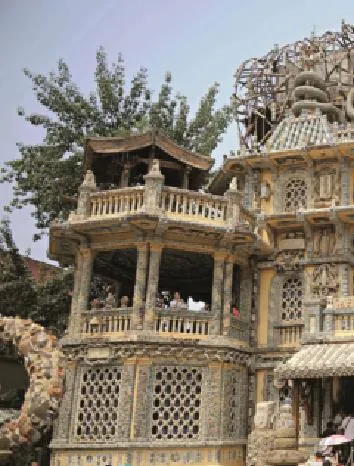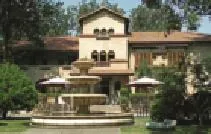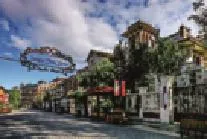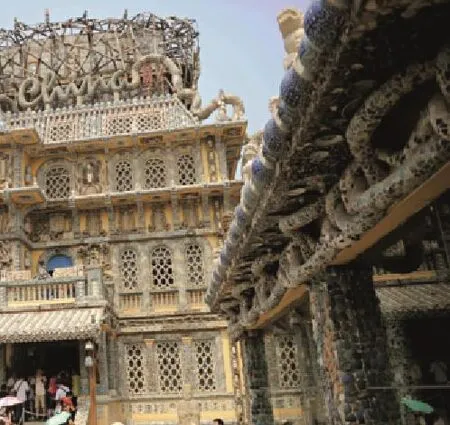CULTURETravel
CULTURETravel
Tips: European architecture in Tianjin is a window showcasing China’s historical changes. The old concessions are very quaint and it is even possible to take a carriageride around the Five-Avenue Area. In the space of an hour you can see the houses of two former presidents and seven former premiers of the Republic of China government (1912-1949) – just like a time traveler.

The Garden of Serenity (Jingyuan)

The Garden of Serenity was constructed in 1921. Originally named Qianyuan Garden, it was first the residence of Lu Zongyu, minister-counselor to Japan, appointed by the Beiyang Government. The last emperor of the Qing Dynasty, Puyi, also lived here after his abdication, from July 1929 to November 1931. He changed the name to Jingyuan, which references his desire to strengthen and ennoble his spirit by living in a peaceful environment.
The main building, built in brick and wood, combines Spanish and Japanese architectural styles. There is a peaceful garden with lawns and trees. An excellent example of an old private residence in Tianjin, the complex is now well-preserved and features an exhibition on Puyi’s life at the Garden of Serenity.
Address: 70 Anshan Road, Heping District
Transport: Anshan Road (Subway Line 1)
Tickets & Opening Hours: Closed Monday; Tuesday to Sunday, 8.30-5pm. RMB 20 per person
Zhangyuan Garden

This grand mansion at 59 Anshan Road, Heping District, was built in 1915 by Zhang Biao, a former high-ranking official in the Qing Court. In 1924, Dr. Sun Yat-sen and his wife Soong Ching Ling stayed in the house for several months. In 1925, Puyi, the last emperor of China, had a brief stay here after he was exiled from Beijing. It was in this house that he set up what he called the “Qing Court Office in Tianjin.” It is certainly a strange coincidence that the founder of the Republic of China and the last emperor chose exactly the same place to live, though at different times – and this odd fact has always interested historians. The mansion is visible from the street, but the buildings and gardens are not open to the public at present.
Italianate Street

Nearly 200 European-style buildings have been conserved in the old Italian Concession and form the modern“Italian-style Street” on the north bank of the Haihe River. The street has been developed as a shopping center and entertainment district. A square named after Marco Polo is surrounded by numerous Italianate edifices. Well-known academics and politicians used to reside here, including Liang Qichao, Cao Yu, Li Shutong, Yuan Shikai, and Feng Guozhang. Pictures of their former residences will be a highlight of your photo albums.
Transport: Jianguo Road (Subway Line 2) gium, Austria-Hungary, and Italy followed suit. As the concession areas expanded, Tianjin gained the feel of a colonial city.
Foreign firms in the British concession constructed the city’s first European-style buildings. These were followed by places of worship, banks, and hotels: institutions like Wanghailou Church, Gordon Hall, the Astor Hotel, the German Club, and the Kailuan Mining Bureau Building, to name but a few. By the beginning of the 20th century, the city had become a forest of highrises.
The number of Western-style residences with gardens also grew. These beautiful houses, built in the style of various European countries, line the banks of the Haihe River. The British, Italian, German, and French concessions boast the most impressive residences. With their manicured lawns, pointed red rooves, and large balconies, the English houses are particularly attractive, just like a painting. There are fve roads in the old British concession which feature the largest number of Europeanstyle buildings. This has become known as the“Five-Avenue Area.”
After foreign residents left the city, their houses were inhabited by various dignitaries, including the royal families of the Qing Dynasty (1644-1911) who had been evicted from the Forbidden City, senior offcials of the Beiyang Government (1912-1928), business tycoons and distinguished personages. Historical buildings, and the people who lived in them, all help to write the legend of the city.
Tianjin Cuisine
Tianjin cuisine has a lot of fans. There is everything from elegant fine dining to deliciousstreet snacks.
Thanks to its location on Bohai Bay, Tianjin has abundant seafood. As opposed to the more delicate way of cooking fish in southern China, seafood in Tianjin is usually served in big bowls and huge dishes, which refects the city’s characteristic openness and lack of pretension.
Merging food from different regions with local favors, Tianjin cuisine has developed into a multiregional food culture. Tianjin food has a distinctive salty and fresh flavour, the product of Shandongstyle cooking, a major culinary infuence. The main cooking methods of Huaiyang Cuisine have also been incorporated; so much of Tianjin’s food is braised or stewed. With easy access to the Grand Canal, linking northern and southern China, Tianjin was able to enjoy some of the specialties of southern China. Things like dried beancurd sticks, dried bamboo, ham, and various southern seasonings are common sights on Tianjin dining tables.
The importance of snacks in Tianjin cuisine should never be ignored. Steamed stuffed buns (baozi) are common all over the country, but Tianjin’s Goubuli, the most famous brand of baozi, turns it into a gourmet meal. Fried dough twists, another well-known local snack, are said to derive from a fried snack made by the Hui ethnic group, called sanzi. In the past, large numbers of Hui people settled along the banks of the Grand Canal and brought sanzi to Tianjin. Locals added more ingredients to the recipe and changed the cooking method, transforming sanzi into popular fried dough twists. Pancakes rolled with spring onions have long been a favourite amongst people in Shandong Province. In Tianjin, the pancake is made of mung bean four and rolled with egg, scallions, and fermented bean sauce. The pancake can also be sliced and served with salty toppings and a slightly spicy sauce. This snack is called guobacai.
Almost every kind of traditional food can be found on the Nanshi Food Street, which is among the city’s top 10 attractions. In addition to numerous restaurants serving traditional Tianjin dishes and snacks, you can also fnd the famous Eight Cuisines of China, encompassing the food of Shandong, Sichuan, Zhejiang, Fujian, Anhui, Guangdong, Hunan, and Jiangsu. Whether you are looking for imperial cuisine, simple home cooking, halal food, vegetarian food, or even Western-style food, Nanshi Food Street has it all. Food streets like this can also be found on Liaoning Road in Heping District and in October Food Street of Hebei District.
(Compiled by China Today)

One of the Europeanstyle buildings in the old French concession is now decorated with hundreds of millions of porcelain fragments, adding a new scenic spot in Tianjin.
Tips: Most snacks in Tianjin are made of flour. Some are deep fried or baked while some are made into sticky sweets. Goubuli steamed stuffed buns (baozi), ear-hole fried cake and Guifaxiang fried dough twists are the top three local snacks.
Goubuli Steamed Stuffed Buns

Going back over 150 years, Goubuli is the most typical Tianjin snack. Its founder Gao Guiyou was nicknamed as“Gouzi” (doggy) when he was a child. A diligent and honest young man, Gao later opened a shop selling his homemade steamed stuffed buns. He was so busy making and selling his steamed buns that he did not even have time to talk to his customers. People joked that“doggy” sold buns and heeded nobody. Then the steamed stuffed buns acquired the name Goubuli, which means a dog that refuses to respond. The buns are known for their selected flour and fillings that are juicy but not greasy. The traditional method of making the buns is now part of the national cultural heritage, and new flavors are also constantly being created.
Earhole Fried Cake

This cake is made of glutinous rice dough. The filling is bean paste made with red beans and sugar. The first shop to sell this dessert was in an alley called Erduoyan (Ear Hole), hence its name. The pastry of the fried cake is crispy and golden, while the filling is tender with a lingering sweet taste. People have been making this Earhole Fried Cake for over 100 years, prompting the China Cuisine Association to name it one of the most famous Chinese snacks.
Shibajie Fried Dough Twists

Guifaxiang, a shop selling fried dough twists, was originally situated on 18th Street, just off South Dagu Road, which made its fried dough twists get the name Shibajie (18th Street). Each portion of dough is stuffed with a variety of fillings such as walnuts, prunes, and sweet osmanthus. The dough twists are then fried in peanut oil and sprinkled with rock candy and dried fruits. The crispy snacks can keep well for several months, and you can also buy small ones.

